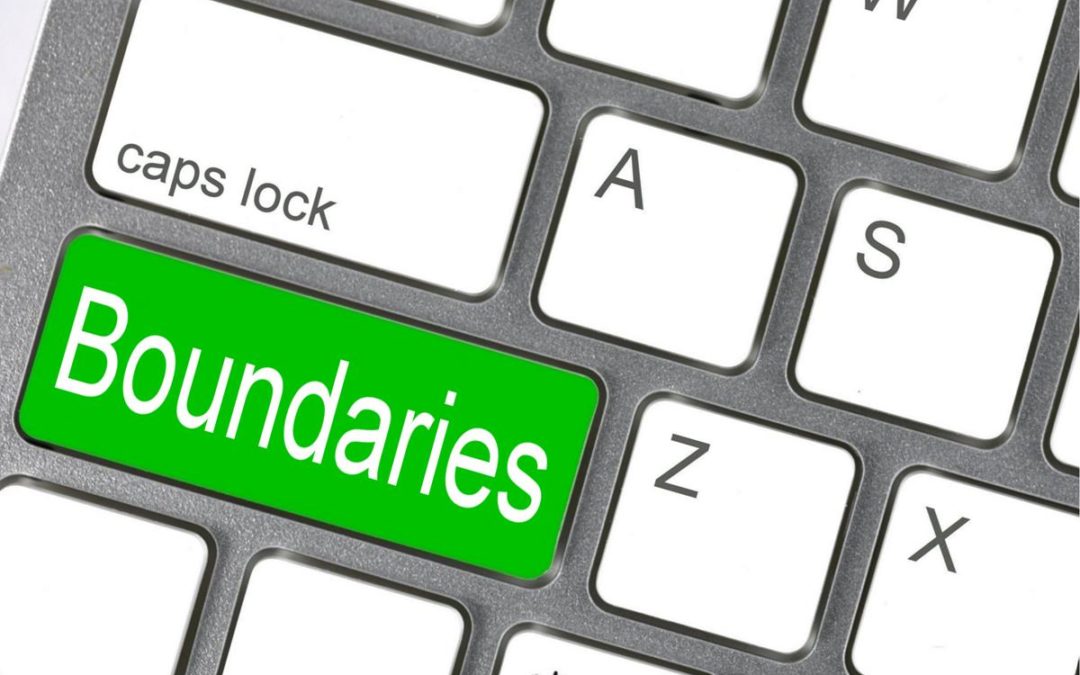Do you take on too many things until your life becomes unmanageable? Do you let people take your time because you feel guilty saying “no”? Do you get easily caught up in other people’s priorities and lose track of yourself? Are you the accommodator who figures out how to maneuver around your relationships rather than being clear about your needs?
If you’ve answered yes to any of these questions, you’re going through life hoping that padding yourself in toilet paper is the answer. It’s easier than setting boundaries.
So why is setting boundaries so hard and how can we make it easier on ourselves?
Find out how to create boundaries that feel collegial at work and good at home.
What are boundaries?
Boundaries are limits you set to communicate where you end and someone else begins. They are there to protect you, to give you more balance, to help you understand yourself and others, and take responsibility for what you let into your space.
According to this definition, boundaries sound amazing. But if they are so great, why are we struggling as much as we are in setting them? Executive coach, Keren Eldad, explains where the breakdown happens:
“Problems don’t always look like problems, but they do feel like problems. They feel like behavioral patterns that are very uncomfortable to us. One of the most common is extreme people pleasing. Overachievers shoot themselves in the foot by saying ‘yes’ a lot, by being liked a lot, by not challenging the status quo, by not making a mistake, by not failing, by not going for their dreams. All of these are forms of not having particularly good boundaries and no empathy for the self. And as a result, you have a life that kind of looks really good, but doesn’t feel very good.”
In fact, there are all different types of obstacles when it comes to boundary setting. Let’s take a closer look at the most common challenges people face when it comes to setting boundaries.
1: You are highly empathic. You feel other people’s feelings and don’t want to disappoint or hurt them.
2: You don’t know what you need. When you lack this self-awareness and someone clearly articulates what they need, it’s easier to just focus on what’s in front of you.
3: You underestimate how long tasks will take and how much time you have left over after accounting for your current commitments.
4: You’re afraid the person will be mad at you or criticize you for turning them down.
5: You think there are only two options: Yes and no.
6: You feel like you’re doing something wrong by saying “no” so you guilt yourself into saying “yes.”
7: You believe if you say “no” you won’t have the right to sit at the table because it takes away from your worth regardless of how much else you’ve done.
8: You believe your needs don’t matter.
9: When you see yourself struggling because you’ve taken too much on, you assume you just need to try harder and take more on.
10: You think of people’s requests as demands.
A big part of setting boundaries is mindset. Too often we make predictions or hold expectations that lead us astray. And even when we set boundaries, we may not follow through on them because we expect people to know they are asking for too much from us or that they are crossing the line. You may decide what your boundary is but not communicate it to others or not make it clear enough so the person understands what you want. Finally, you might create a limit in your mind about where you’ll draw the line, but end up crossing that line and doing more than you set out to do.
It’s important to understand what gets in the way of setting boundaries to avoid the downsides of not having them properly in place.
The Downsides to Poor Boundaries
Boundaries are challenging to set for a number of reasons, but when we don’t have good boundaries in place, there are some consequences we have to face. Here are 10 potential downsides to poor boundaries:
1: You become easily affected by other people’s moods.
2: You become overwhelmed after absorbing too much of other people’s energy.
3: Because you’ve overcommitted yourself, you are not succeeding at your priorities.
4: You end up spending time and energy on experiences you don’t want. Saying “yes” to them is saying “no” to yourself.
5: You get unconsciously sucked into other people’s drama.
6: Life can lose its meaning because you’re living someone else’s life instead of your own.
7: If people don’t respond the way you would like them to after you deliver on your promise, you might become upset with them or beat yourself up for not being competent enough.
8: You expect the other person to reciprocate the favor and if you don’t get what you think you should, you feel unappreciated.
9: You calculate how much you do for others and feel resentful of them for the lack of balance.
10: You run out of steam.
There are so many consequences to poor boundaries including that taking on more than we can chew can lead to burnout.
How Do I Set Healthy Boundaries?
By now you likely have some buy-in. You want to create some healthy boundaries but not know how to do so. But what do healthy boundaries even look like, you might wonder?
According to energy healer, Jeffrey Allen, boundaries are about permeability. When permeability of your boundaries is too low, you become “insensitive, defensive, protective, aloof, or demanding. It’s when you understand yourself but not others.” The other extreme is when you have high permeability and you are too sensitive, have no boundaries, are absorbing other people’s energy, and understand others but lose yourself. The ideal is finding a balance where you understand and respect both yourself and others.
Here are 10 rules for creating balanced boundaries:
1: Clear any energy you’ve absorbed that’s not yours and that doesn’t serve you. An easy way to do this is to imagine you have a grounding cord that drops down from the base of your spine and connects you to the center of the earth. Send any unwanted energy down this cord. This will help you get back to yourself.
2: If someone is in your space, this is an indication that you need to adjust your boundary. Keep fine tuning it until there are no more unwanted intrusions.
3: Determine in advance what you will focus your time and attention on and let these goals guide you rather than the interruptions that follow.
4: Treat everything as a request, not a demand.
5: Give yourself a menu of options with which to respond to requests from others. These can include:
- Yes
- No
- Not now
- I can do just this part
- I can take this on if we take something else off my plate
- Let me get back to you
- Give me [insert time frame] and I’ll come find you
6: Take full responsibility for communicating your boundaries to others. They are not mind readers and they don’t necessarily know when they are crossing your boundary.
7: When you set a boundary, follow through on it.
8: Trying harder is not going to fix how you feel and doing more is not the answer. If you’re exhausted, it’s time to take a break.
9: Ask yourself, “What am I willing to do? What’s pro me AND pro you?”
10: If you’re being asked to work on a new project before you’re done with your current one, ask the person to prioritize. Give them the two options and find out what’s most important for you to work on in this moment.
How Boundaries Can Help You Avoid Conflict
I recently interviewed parenting coach, Amy Armstrong, on how boundaries can help avoid conflict with others. In that interview, Amy shared a concrete example that illustrates boundaried communication.
Amy’s tip is to validate the other person, even if you don’t agree with them, while still honoring your point of view.
Imagine you’re talking to a colleague and you disagree on an issue related to work. Amy suggests you say, “We’re not on the same page. We totally get that. We see it differently. You see it like this, and I see it like that.” Another option might be to say, “Oh, I can tell that you’re most worried about X and I’m most worried about Y.” In essence, you’re just summarizing the two sides.
What I love about this approach is that it’s simple, it’s validating, and it gives you time to consider your next step instead of being reactive. This shows that you don’t need to compromise to resolve conflict. You can focus instead on what’s important to both parties and let the solutions emerge organically.
Conclusion
Boundaries are here to protect us. They allow us to live a more balanced life, to clear out unwanted energy belonging to others, and stick to what we value most.
While it may feel challenging to override the negative emotions like fear and guilt to set boundaries, if we want to avoid building up resentment and burning out, we would be wise to work on this skill.
And yes, it is a skill. This is good news. You can change the thoughts that lead to people- pleasing. You can say “no” to others and “yes” to yourself. Let’s get you on board.
—————————-
Check out the training I specially created called, How to Stop Being a People Pleaser, Set Boundaries without the Guilt, and Avoid Burnout.
Author



Recent Comments